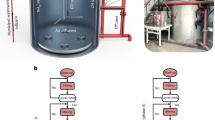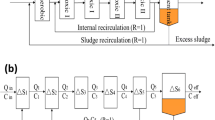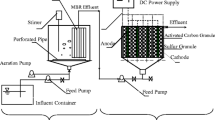Abstract
Energy-positive sewage treatment can, in principle, be obtained by maximizing energy recovery from concentrated organics and by minimizing energy consumption for concentration and residual nitrogen removal in the main stream. To test the feasibility of the latter, sewage-like nitrogen influent concentrations were treated with oxygen-limited autotrophic nitrification/denitrification (OLAND) in a lab-scale rotating biological contactor at 25°C. At influent ammonium concentrations of 66 and 29 mg N L−1 and a volumetric loading rate of 840 mg N L−1 day−1 yielding hydraulic residence times (HRT) of 2.0 and 1.0 h, respectively, relatively high nitrogen removal rates of 444 and 383 mg N L−1 day−1 were obtained, respectively. At low nitrogen levels, adapted nitritation and anammox communities were established. The decrease in nitrogen removal was due to decreased anammox and increased nitratation, with Nitrospira representing 6% of the biofilm. The latter likely occurred given the absence of dissolved oxygen (DO) control, since decreasing the DO concentration from 1.4 to 1.2 mg O2 L−1 decreased nitratation by 35% and increased anammox by 32%. Provided a sufficient suppression of nitratation, this study showed the feasibility of OLAND to treat low nitrogen levels at low HRT, a prerequisite to energy-positive sewage treatment.



Similar content being viewed by others
References
Abma WR, Driessen W, Haarhuis R, van Loosdrecht MCM (2010) Upgrading of sewage treatment plant by sustainable and cost-effective separate treatment of industrial wastewater, Water Sci Technol 61:1715–1722
Amann RI, Krumholz L, Stahl DA (1990) Fluorescent-oligonucleotide probing of whole cells for determinative, phylogenetic, and environmental-studies in microbiology. J Bacteriol 172:762–770
Anthonisen AC, Loehr RC, Prakasam TBS, Srinath EG (1976) Inhibition of nitrification by ammonia and nitrous-acid. J Water Pollut Control Fed 48:835–852
Bernet N, Dangcong P, Delgenes JP, Moletta R (2001) Nitrification at low oxygen concentration in biofilm reactor. Journal of Environmental Engineering-Asce 127:266–271
Brombach H, Weiss G, Fuchs S (2005) A new database on urban runoff pollution: comparison of separate and combined sewer systems. Water Sci Technol 51:119–128
De Clippeleir H, Vlaeminck SE, Carballa M, Verstraete W (2009) A low volumetric exchange ratio allows high autotrophic nitrogen removal in a sequencing batch reactor. Bioresour Technol 100:5010–5015
Desloover J, De Clippeleir H, Boeckx P, Du Laing G, Colsen J, Verstraete W, Vlaeminck SE (2011) Floc-based sequential partial nitritation and anammox at full scale with contrasting N2O emissions. Water Res. doi:https://doi.org/10.1016/j.watres.2011.02.028
European Commission (1991) Council Directive 91/271/EEC of 21 May 1991 concerning urban waste-water treatment. Official Journal L 135:40–52
Fux C, Siegrist H (2004) Nitrogen removal from sludge digester liquids by nitrification/denitrification or partial nitritation/anammox: environmental and economical considerations. Water Sci Technol 50:19–26
Greenberg AE, Clesceri LS, Eaton AD (1992) Standard methods for the examination of water and wastewater. American Public Health Association, Washington DC
Henze M (1997) Waste design for households with respect to water, organics and nutrients. Water Sci Technol 35:113–120
Henze M, Van Loosdrecht MCM, Ekama GA, Brdjanovic D (2008) Biological wastewater treatment: principles, modelling and design. IWA publishing, London
Hippen A, Rosenwinkel KH, Baumgarten G, Seyfried CF (1997) Aerobic deammonification: a new experience in the treatment of wastewaters. Water Sci Technol 35:111–120
Jeanningros Y, Vlaeminck SE, Kaldate A, Verstraete W, Graveleau L (2010) Fast start-up of a pilot-scale deammonification sequencing batch reactor from an activated sludge inoculum. Water Sci Technol 61:1393–1400
Joss A, Salzgeber D, Eugster J, Konig R, Rottermann K, Burger S, Fabijan P, Leumann S, Mohn J, Siegrist H (2009) Full-scale nitrogen removal from digester liquid with partial nitritation and anammox in one SBR. Environ Sci Technol 43:5301–5306
Kartal B, Kuenen JG, van Loosdrecht MCM (2010) Sewage treatment with anammox. Science 328:702–703
Kuai LP, Verstraete W (1998) Ammonium removal by the oxygen-limited autotrophic nitrification-denitrification system. Appl Environ Microbiol 64:4500–4506
Lackner S, Terada A, Smets BF (2008) Heterotrophic activity compromises autotrophic nitrogen removal in membrane-aerated biofilms: results of a modeling study. Water Res 42:1102–1112
Loy A, Horn M, Wagner M (2003) probeBase: an online resource for rRNA-targeted oligonucleotide probes. Nucleic Acids Res 31:514–516
Lücker, S. (2010) Exploring the ecology and genomics of globally important nitrite-oxidizing bacteria. In. Wien: Universität Wien. 142.
Lücker S, Wagner M, Maixner F, Pelletier E, Koch H, Vacherie B, Rattei T, Damste JSS, Spieck E, Le Paslier D, Daims H (2010) A Nitrospira metagenome illuminates the physiology and evolution of globally important nitrite-oxidizing bacteria. Proc Natl Acad Sci USA 107:13479–13484
Mathure P, Patwardhan A (2005) Comparison of mass transfer efficiency in horizontal rotating packed beds and rotating biological contactors. J Chem Technol Biotechnol 80:413–419
Meulman B, Elzinger N, Gorter K, Zeeman Z, Buisman CJN, Vlaeminck SE, Verstraete W (2010) Pilot-scale demonstration of sustainable C and N removal from concentrated black water. IWA World Water Congress & Exhibition, Montréal, Canada
Mulder A (2003) The quest for sustainable nitrogen removal technologies. Water Sci Technol 48:67–75
Pynaert K, Smets BF, Wyffels S, Beheydt D, Siciliano SD, Verstraete W (2003) Characterization of an autotrophic nitrogen-removing biofilm from a highly loaded lab-scale rotating biological contactor. Appl Environ Microbiol 69:3626–3635
Pynaert K, Smets BF, Beheydt D, Verstraete W (2004) Start-up of autotrophic nitrogen removal reactors via sequential biocatalyst addition. Environ Sci Technol 38:1228–1235
Schmid M, Walsh K, Webb R, Rijpstra WIC, van de Pas-Schoonen K, Verbruggen MJ, Hill T, Moffett B, Fuerst J, Schouten S, Damste JSS, Harris J, Shaw P, Jetten M, Strous M (2003) Candidatus “Scalindua brodae”, sp nov., Candidatus “Scalindua wagneri”, sp nov., two new species of anaerobic ammonium oxidizing bacteria. Syst Appl Microbiol 26:529–538
Siegrist H, Reithaar S, Koch G, Lais P (1998) Nitrogen loss in a nitrifying rotating contactor treating ammonium-rich wastewater without organic carbon. Water Sci Technol 38:241–248
Siegrist H, Salzgeber D, Eugster J, Joss A (2008) Anammox brings WWTP closer to energy autarky due to increased biogas production and reduced aeration energy for N-removal. Water Sci Technol 57:383–388
Szatkowska B, Cema G, Plaza E, Trela J, Hultman B (2007) A one-stage system with partial nitritation and anammox processes in the moving-bed biofilm reactor. Water Sci Technol 55:19–26
Tchobanoglous G, Burton FL, Stensel HD (2003) Wastewater engineering, treatment and reuse - Metcalf & Eddy. McGraw-Hill, New York
Verstraete W, Vlaeminck SE (2011) ZeroWasteWater: short-cycling of wastewater resources for sustainable cities of the future. International Journal of Sustainable Development and World Ecology (in press)
Verstraete W, de Caveye PV, Diamantis V (2009) Maximum use of resources present in domestic “used water”. Bioresour Technol 100:5537–5545
Vlaeminck SE, Terada A, Smets BF, Van der Linden D, Boon N, Verstraete W, Carballa M (2009) Nitrogen removal from digested black water by one-stage partial nitritation and anammox. Environ Sci Technol 43:5035–5041
Vlaeminck SE, Terada A, Smets BF, De Clippeleir H, Schaubroeck T, Bolca S, Demeestere L, Mast J, Boon N, Carballa M, Verstraete W (2010) Aggregate size and architecture determine microbial activity balance for one-stage partial nitritation and anammox. Appl Environ Microbiol 76:900–909
Vlaeminck SE, Hay A, Maignien L, Verstraete W (2011) In quest of the nitrogen oxidizing prokaryotes of the early Earth. Environ Microbiol 13:283–295
Wett B, Buchauer K, Fimml C (2007) Energy self-sufficiency as a feasible concept for wastewater treatment systems. In: IWA Leading Edge Technology conference. Singapore.
Wett B, Nyhuis G, Hell M, Takacs I, Murthy S (2010) Development of enhanced deammonification selector. In: WEFTEC10. New Orleans.
Zessner M, Lampert C, Kroiss H, Lindtner S (2010) Cost comparison of wastewater in Danubian countries. Water Sci Technol 62:223–230
Acknowledgments
H.D.C. received a PhD grant from the Institute for the Promotion of Innovation by Science and Technology in Flanders (IWT-Vlaanderen, SB-81068), and S.E.V. was supported as a postdoctoral fellow from the Research Foundation Flanders (FWO-Vlaanderen). The authors gratefully thank Hans Mollen (Waterschap Brabantse Delta, the Netherlands) for sharing temperature data, Siska Maertens for molecular analyses, and Nico Boon, Tom Hennebel, Jan Arends, Yu Zhang, Sebastià Puig, and Samik Bagchi for inspiring scientific discussions.
Author information
Authors and Affiliations
Corresponding author
Rights and permissions
About this article
Cite this article
De Clippeleir, H., Yan, X., Verstraete, W. et al. OLAND is feasible to treat sewage-like nitrogen concentrations at low hydraulic residence times. Appl Microbiol Biotechnol 90, 1537–1545 (2011). https://doi.org/10.1007/s00253-011-3222-6
Received:
Revised:
Accepted:
Published:
Issue Date:
DOI: https://doi.org/10.1007/s00253-011-3222-6




